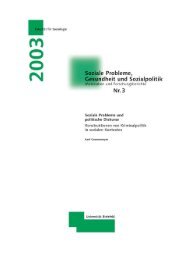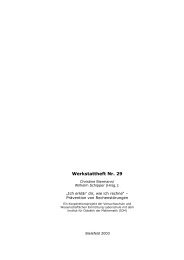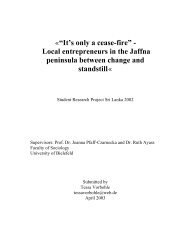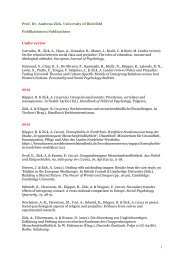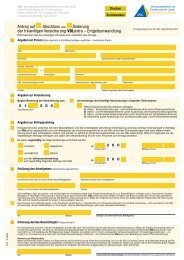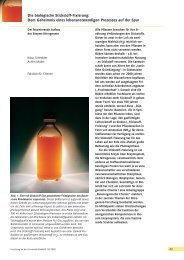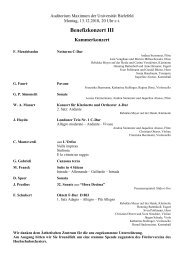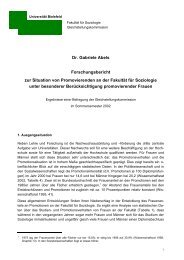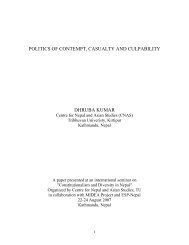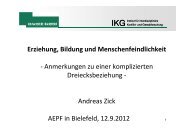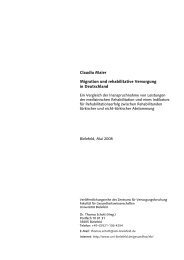Madheshi Nationalism and Restructuring the Nepali State
Madheshi Nationalism and Restructuring the Nepali State
Madheshi Nationalism and Restructuring the Nepali State
You also want an ePaper? Increase the reach of your titles
YUMPU automatically turns print PDFs into web optimized ePapers that Google loves.
The Madhesh uprising has a component of deterrence against <strong>the</strong> rising influence of <strong>the</strong> CPN<br />
(Maoist). The first victim of <strong>the</strong> Madhesh unrest was Ramesh Kumar Mahato, a MJF cadre, who<br />
was shot by <strong>the</strong> CPN (Maoist) activists. This event just led to add <strong>and</strong> sharpen anti-Maoist<br />
component of <strong>the</strong> Madhesh movement. As <strong>the</strong>re had already been several incidents of bloody<br />
encounters between <strong>the</strong> activists of <strong>the</strong> <strong>Madheshi</strong> groups – TJMM <strong>and</strong> MJF – <strong>and</strong> <strong>the</strong> CPN<br />
(Maoist) since before <strong>the</strong> call of <strong>the</strong> Madhesh <strong>and</strong>olan from 16 Janaury 2007. The CPN (Maoist)<br />
<strong>and</strong> o<strong>the</strong>r political parties suspected <strong>the</strong> h<strong>and</strong> or reactionary elements <strong>and</strong> Hindu fundamentalists<br />
of India. The CPN (Maoist) supremo, Prach<strong>and</strong>a, publicly called to deal it with coercive<br />
measures which fur<strong>the</strong>r fuelled anti-Maoists sentiment of <strong>the</strong> Madhesh agitators. The Gaur<br />
incident of Rautahat district was <strong>the</strong> climax <strong>and</strong> <strong>the</strong> final show of confrontation between <strong>the</strong> MJF<br />
<strong>and</strong> <strong>the</strong> CPN (M) in which 27 Maoists were killed.<br />
The leadership of <strong>the</strong> recent Madhesh movement were all Maoists at one point. Splitting from <strong>the</strong><br />
CPN (Maoist), <strong>the</strong>y have confronted <strong>the</strong>ir one-time Maoist colleagues <strong>and</strong> also competed with<br />
political parties to capture support within Madhesh. During <strong>the</strong> Madhesh unrest, some leaders of<br />
<strong>the</strong> mainstream parties were victimized, but relatively less so when compared to <strong>the</strong> suffering of<br />
<strong>the</strong> Maoist activists. In retrospect, <strong>the</strong>re would appear to be some irony in <strong>the</strong> fact that <strong>the</strong> CPN<br />
(Maoist) provided <strong>the</strong> basis for <strong>the</strong> rise of militant <strong>Madheshi</strong> nationalism – which was in<br />
conformity to its strategy of ethnicization of <strong>the</strong>ir insurgency – but this later turned <strong>and</strong> backfired<br />
in a spectacular way. With <strong>the</strong> slogan – ‘say it with pride, we are <strong>Madheshi</strong>’ – <strong>the</strong> CPN<br />
(Maoist)’s front organization Madhesh National Liberation Front (MNLF) – formed in 2000 –<br />
was actively mobilized in <strong>the</strong> Madhesh during <strong>the</strong> time of insurgency. Most of <strong>the</strong> dem<strong>and</strong>s<br />
raised by <strong>the</strong> MJF <strong>and</strong> o<strong>the</strong>r <strong>Madheshi</strong> groups – i.e. inclusion, federalism with right to self<br />
determination, language <strong>and</strong> culture rights, reservation etc. – have already been raised by <strong>the</strong><br />
MNLF. Replacement of <strong>the</strong> MNLF founder leader Jai Krishna Goait by Matrika Prasad Yadav as<br />
leadership of <strong>the</strong> front in July 2004 led to a split with <strong>the</strong> formation of TJMM by dissidents. The<br />
dissidents, hence, confronted with <strong>the</strong> Maoist cadres <strong>and</strong> <strong>the</strong>y actively campaigned that <strong>the</strong> CPN<br />
(Maoist)’s pro-<strong>Madheshi</strong> posture was fake. This position was accepted by several o<strong>the</strong>r small<br />
Madhesh armed groups including a splinter group of <strong>the</strong> TJMM (Jwala Singh) <strong>and</strong> <strong>the</strong> MJF.<br />
Nepal Democracy Survey 2007 revealed <strong>the</strong> <strong>Madheshi</strong>s’ anti-Maoist posture: <strong>the</strong> majority of<br />
respondents belonging to <strong>the</strong> <strong>Madheshi</strong> castes <strong>and</strong> Muslim ‘distrusted’ <strong>the</strong> CPN (Maoist) nor did<br />
<strong>the</strong>y believe in <strong>the</strong> CPN (Maoist)’s recent commitment to multiparty system. By contrast, <strong>the</strong><br />
majority of <strong>the</strong> hill respondents showed trust in <strong>the</strong> Maoists’ commitments. 9<br />
The local <strong>Madheshi</strong> leaders of <strong>the</strong> NC, UML <strong>and</strong> o<strong>the</strong>r parties gave up <strong>the</strong> idea of countering <strong>the</strong><br />
Madhesh unrest when it became clear that it was turning into an anti-Maoist agitation. The call<br />
for sadbhav rallies – which was effective in Nepalgunj against communal violence happened just<br />
before <strong>the</strong> starting of Madhesh <strong>and</strong>olan from 16 January 2007 – appeared ritualistic. It was a<br />
tactical resistance against <strong>the</strong> CPN (Maoist). The flags of established parties failed to deter <strong>the</strong><br />
CPN (Maoist)’s long aggressive campaigns launched by its People Liberation Army (PLA)<br />
during <strong>the</strong> insurgency period <strong>and</strong> by <strong>the</strong> Young Communist League (YCL) in <strong>the</strong> post-<br />
Jan<strong>and</strong>olan II time. Whereas <strong>the</strong> militant Madhesh uprising proved an effective counter to <strong>the</strong><br />
CPN (Maoist). To quote from <strong>the</strong> ICG report, “For <strong>the</strong> Maoists, <strong>the</strong> Tarai violence was a wake<br />
9 Party-wise disaggregated data of <strong>the</strong> same survey <strong>and</strong> a subsequent elite survey show that <strong>the</strong> majority of parties’<br />
sympathizers <strong>and</strong> majority members of <strong>the</strong> present interim parliament ‘distrusted’ <strong>the</strong> CPN (Maoist).<br />
7



